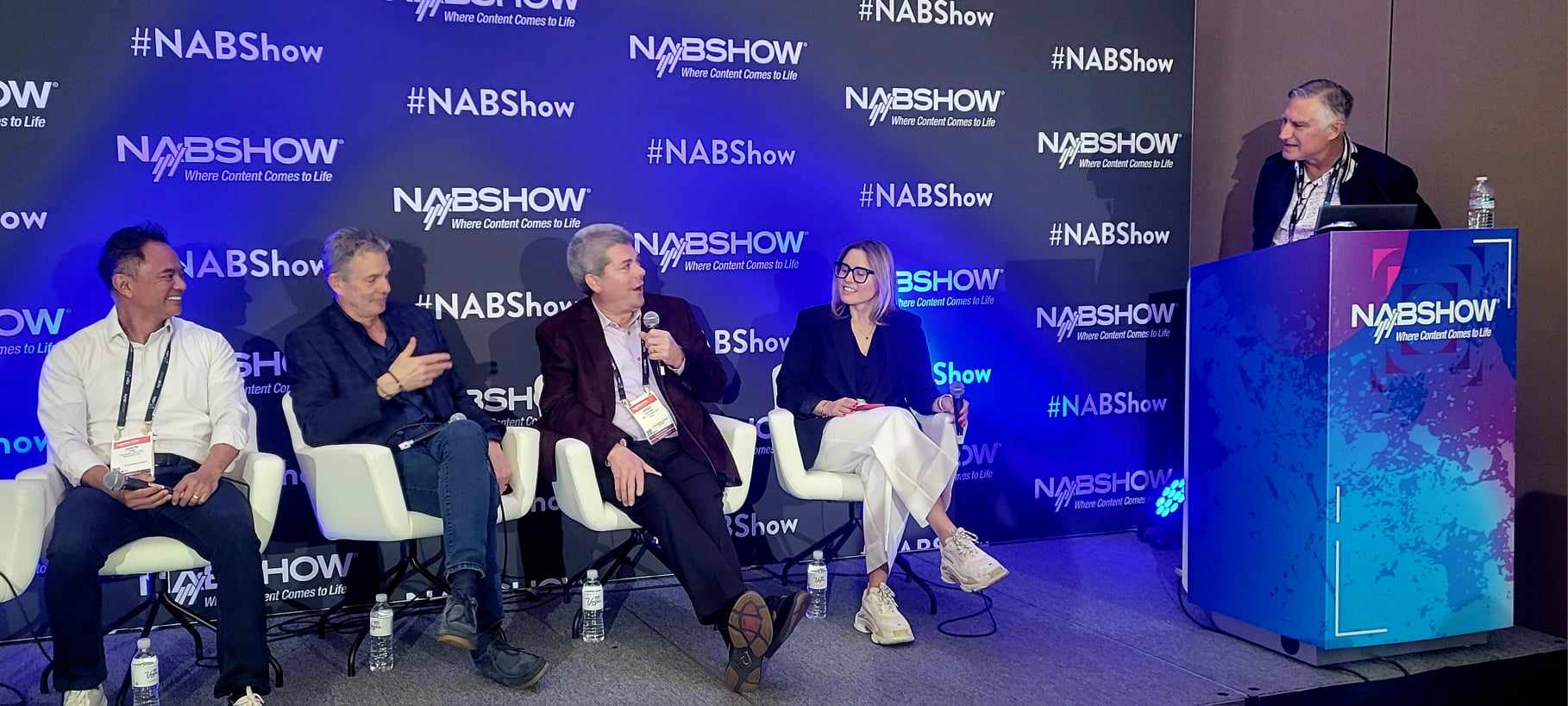NAB Show: Creative Lens on Live Sports
Sports audiences are old; to attract younger viewers, producers need to make sports more engaging and interactive

LAS VEGAS—The premise of the 2024 NAB Show's "Creative Lens on Live Sports: Next Gen Video Production and Fan Experiences" session was very simple to understand if one casts a discerning eye across the broadcast landscape.
In July 2023, linear TV made up less than half of all TV viewing, according to Nielsen. So all of those content craving eyeballs have gone to other screens, with the big push about streaming and the demands of today’s market.
That’s largely because cable isn’t interactive. And interactivity and the ability to produce one’s own experience is what much of the market, notably Gen Z (the demographic of people born from the late 1990s through the early 2010s) ― wants.
Unlocking Data
“The average age of viewers of most of the major sports leagues is mid-50s,” said Matt Coleman, CEO of Las Vegas-based FansXR and the panel’s moderator. “The younger generation isn’t watching cable.”
Coleman is leading the charge armed with recent data from Deloitte, for instance, from a recent survey that revealed that 67% of Gen Z want interaction when it comes to watching a sporting event.
“Another key point is that 64% of Gen Z viewers say they want their experience to be more immersive, too,” he said. “Generally, our panel was based around next-gen technology and engagement. That’s the main data to unlock, because there is a broad feeling in the industry that using artificial intelligence, biometrics and player tracking are options that fans are really interested in.”
The professional video industry's #1 source for news, trends and product and tech information. Sign up below.
What that does is allow users (or fans) to tailor a broadcast sporting event into a personal experience. “The younger generation is not really interested in linear experiences that one finds on broadcast, YouTube, etc.” he said. “They expect something interactive that they can control, like they can on TikTok, Xbox and social media.”
A 5G Thing
They also want to gamble. Coleman cited stat companies, such as Genius Sports (NFL), Sportradar (NBA) and Stats Perform as heavy investors in new data sets and apps for sports when it comes to leagues, like NBA, NFL, FIFA, MLB and the NHL, that can allow in-game betting or prop betting using the likes of FanDuel or DraftKings.
For in-game betting, “The product has to transmit in real-time, so that’s a key part of this equation,” said Coleman, noting that FansXR uses Verizon or T Mobile 5G to operate its system. “We’re one of the first companies globally to work with soccer with TV Azteca (Liga MX) and we launched a real-time product with up to six 2-D and 360 cameras in a web URL interface. The project is sponsored by Caliente, which is looking for new ways to connect with fans; in this case, it’s a second screen experience for the main 2-D broadcast and that drives new sponsorship and advertising for the broadcaster and FansXR.”
And what does it offer fans? “Another way to watch soccer and become their own director,” he said, “as the leagues’ exclusive suppliers provide the data to all of the sports books and the sports books, in turn, present the odds.
“Our product has new software (with the patent pending) and edge compute hardware, and facilitates in-game betting,” he said. “We’ve already done a number of projects, such as the horse racing project where you can could bet in real time at the race track while jumping horse to horse using 360 cameras and LIGA MEX with Azteca, installing our server and cameras onsite at Estadio Cuauhtémoc, in Puebla, Mexico, with Caliente.”
See It Now
Concerning big projects, the session panelists had plenty to talk about. For instance, Ally Coulsen, marketing director for London-based Disguise, discussed the recent effort to turn NBA courts “into giant TV screens” where players are tracked as they moved across a glass floor.
That calls for bringing in data to create “a more immersive experience,” she said, also noting ESPN’s Catalyst Stage as an example “of a fully immersive XR stage for broadcast,” which serves as “a digital twin” that “changes the game in terms of how you broadcast and tell stories.”
Jason Yim, CEO of Los Angeles-based Trigger XR, pointed out “the cinematic quality” of the video and how this trend is extending beyond, but still melds with, the sports world. “We do a lot of work for the theme parks,” with clients like Imagineering, which is “not just the two hours a sports event happens,” he said.
Yim also discussed how Trigger XR was involved in a project with Verizon “a couple of Super Bowls back” where the viewer “could plant an AR door in your room, step through,” said Yim, “and then you’d be on stage at the Half-Time Show. “A half-million people were in the portal at one time for an average of nine minutes,” he said. “That proves the consumer wants this content.”
He also noted how the firm has worked with the NHL “first to take the telemetry from the puck and players and actually present it in AR,” which could be watched on Apple Vision Pro and META.
The 5G world and the cloud offer so many options, Yim said, “that you have to work through what the user really wants out of it.”
That’s especially key for Gen Zers. Tim Stevens, global leader, strategic innovation, sports, media and entertainment for Verizon, noted an event in the corporation’s booth at NAB later that afternoon: cutting an NHL game between the New York Islanders and the New Jersey Devils with only five ISO feeds that were mixed in the cloud using 5G and edge computing architecture.
“What is important is taking the live camera feeds to the cloud that are delivered back” with “HLS streaming and delivering it to handsets on the floor,” said Stevens, in “roughly about one second.”
The reason that’s important, he said, is that latency had been several seconds ahead because they ended up 20-30 seconds ahead on handsets; however, taking that latency out of the equation ensures that the fans outside the venue “have a same, very similar or even unique experience,” he said, to those inside, which opens the door for in-game betting.
“The only way to do that,” said Stevens, “is to make sure that data matches the video. That’s the biggest component.”
Finding Formulas
Grant Nodine, senior vice president of technology for the NHL, continued. “The biggest thing we’ve found,” he said, is that today’s tech flexibility enables the league “to differentiate the content” for the generational divide and offer new ways to present a hockey game.
“So being able to give them an experience that mirrors what they are after in the event,” he said, “is the most important thing.”
That can even include something as off-the-wall as using the Warner [Bros.] characters with its content. Such moves open new markets, as does live cut production, which Nodine felt is the best way to package content “to produce a very unique output.”
The question is, “How do we find the right formula,” he queried, for various sectors of the NHL fan base when the league airs “1,500 live events a year?” Experimentation has been the answer to that burning question as the technology march continues.
“Our company is only six years into sports and we’re expecting a big upswing in that sector, notably in the in-game part of the market. It’s not just pregame anymore,” Coleman said. “By following in-game, that can personalize an experience Gen Z viewers (among others) want to make it more immersive.
Stevens reflected on just how far the market is already, well, immersed (if you will) into this new age.
“We are so far beyond the mass market. I remember as a broadcaster 20 years ago I had one [live linear] product on the shelf. That’s all I needed. Now the iterations of all the product” are for “different countries and globals, different types of experiences, different platforms,” he said. “It’s mind-boggling. But that’s the only way to really meet the demands of the industry.”
These new technologies “give us the core fabric,” said Stevens, “to start doing that.”
Mark R. Smith has covered the media industry for a variety of industry publications, with his articles for TV Technology often focusing on sports. He’s written numerous stories about all of the major U.S. sports leagues.
Based in the Baltimore-Washington area, the byline of Smith, who has also served as the long-time editor-in-chief for The Business Monthly, Columbia, Md., initially appeared in TV Technology and in another Futurenet publication, Mix, in the late ’90s. His work has also appeared in numerous other publications.

